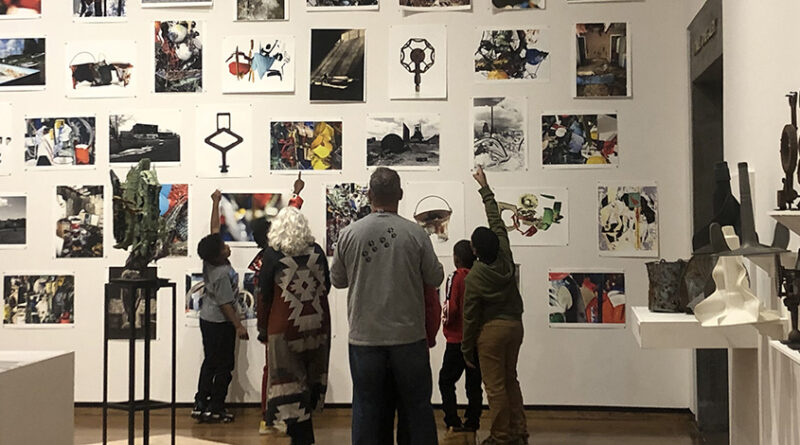Museum Docents
Tour guides in Syracuse’s Everson Museum of Art and Erie Canal Museum add a new dimension to visitors’ experiences.
By Carol Radin
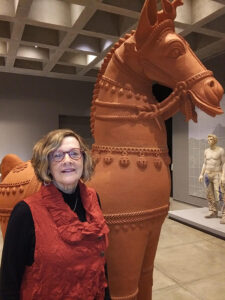
What to think when staring at a three-foot high sculpture of sharp ceramic webs and cloud-like shapes punctuated by spikes of common appliance parts? Mysterious — until docent Ellen Hardy points to the structure’s center and peers inside.
“There’s actually a heart inside there. Do you see it?” Then she straightens and sweeps one arm outward toward the gallery’s expanse of sculptures by Raymon Elozua. “Each one has a heart in the center,” she said and suddenly we are intrigued and engaged.
Hardy, 76, has been a docent, or tour guide, for the Everson Museum of Art in Syracuse for 14 years. She volunteers about 25 hours a month. A retired vice principal in the North Syracuse School District whose teaching discipline was French, she applied when the museum was looking for someone who could lead tours in French during the French Impressionism Artists’ exhibition in 2008.
“I like that I can stay in touch with teaching,” Hardy said. “It is lifelong learning.”
The same could be said for Henry Zucker, 80, a volunteer guide at Syracuse’s Erie Canal Museum. The retired librarian from Rome loves facts and knows a lot of them. The museum building itself?
“The Weighlock Building—circa 1850—was nothing but a tollbooth!” The barrels?—They carried Lake Erie water to the Hudson River water for a ceremonial blending called the “Wedding of the Waters.”
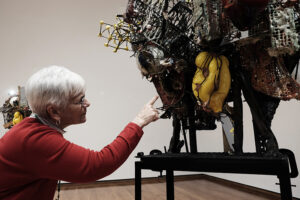
He will even quote classic American writers Herman Melville and Nathaniel Hawthorne, who wrote of their experiences on the canal packet boats back in the 1800s.
Many retirees make up the volunteer docent groups in both the Everson Museum of Art and the Erie Canal Museum. It is an enriching relationship for all concerned. The museum staff and the volunteers learn much from each other, and they pass on a quality experience to museum visitors and to the Syracuse community itself.
While Hardy and Zucker both have backgrounds in education, that is not required nor is it particularly common among other docents.
Said Derrick Pratt, the Erie Canal Museum’s director of education and public programs, “We have retired librarians, teachers, police officers, grocer distributors, pilots, insurance adjusters and nutritionists to name a few. I’ve learned quite a bit from our volunteers over the years, especially since they come from a wide variety of backgrounds.”
Retired nutritionist and dietitian Dorothy Hares, 73, for instance, is a Canal Museum tour guide who has drawn on her professional background for one of her learning activities. As a tie-in to the kinds of food that were transported in canal barges, Hares arranged for the curator of the food exhibit to give a presentation to members of the local dietetic organization about the foods that native peoples in 19th century New York were growing and how those foods evolved to become part of our current diet.
How does a nutritionist decide to guide tours in a museum about New York State history? Again, the yen for life-long learning.
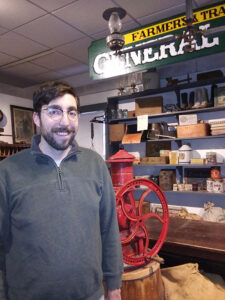
Through the docent training and in-service opportunities, Hares has immersed herself in local history.
“I’ve had a chance to read documents from the 1850s. I’ve worked with another docent who’s been examining maps, and to see that amount of detail—like Oneida Lake—you get a sense of how people then were seeing the lake.”
Hares, a Baldwinsville resident, has also become acquainted with surviving relics of the Erie Canal when doing walking tours through Syracuse’s downtown Clinton Square.
“Why is that door there? On the second floor, on the outside of the building?” she might ask, directing visitors to look up at the brick Phoenix building. If they can’t guess, she tells them that it is to accommodate the height of the freight barges and the unloading of cargo.
The Erie Canal Museum currently has 15 tour guides. Even Pratt’s mother, Carol Pratt, 67, has joined the ranks. Derrick Pratt, who has a degree in social studies and was a former director of programs for the Chittenango Landing Museum, does the orientation and training over two days. New tour guides get a thorough background on the museum and the canal itself, as well as a script for each display—scripts which guides like Zucker and Hares enhance with their own ideas, of course. On their first tours, guides are accompanied by an experienced tour guide.
The Everson Museum of Art also has a formal training program for docents.
Shari Merten, the learning and engagement coordinator, coordinates the museum’s recruiting, training, and in-service opportunities. Merten, whose degree is in museum studies, with an emphasis on education and media studies, has implemented a number of ideas and projects to keep the docents energized. Initially, she likes to focus on visual thinking strategies. In essence, the docent engages observers by “asking what you see and explaining why you think that, to think deeply about how we perceive things.”
The docents take a three-day workshop and do their first several tours with an experienced docent. Ultimately, Merten appreciates that “Everyone brings a different skill set.”
So her intention is just as much to “leave it open” for docents to follow their personal approaches to tours.
With Merten’s support, several docents also choose to take learning activities out to the Syracuse community. Ellen Hardy has facilitated learning activities at such places as Hazard Branch Library on Syracuse’s west side, the Veterans’ Administration Hospital, and RISE, the Center for Refugee and Immigrant Self-Empowerment in Syracuse. Hardy recalls a wonderful school activity in which she and the students made clay necklaces as a way of connecting to Syracuse artist Sharif Bey’s “Facets” exhibition of African-American ceramics and sculpture in 2022.
Hardy and the other docents see many school groups, particularly in the fall when the Everson invites all fifth graders in the Syracuse School District for tours. October 2022, the museum hosted a total of 1,300 school students.
“The kids are like sponges!” Hardy exclaimed, all smiles.
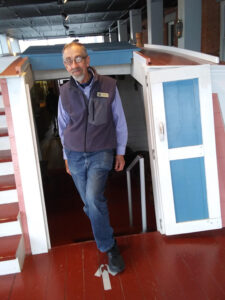
Another Everson docent, Deb Meyer, 74, has taken docent involvement to yet another level. In her role as the Everson’s president of the docents, she became the regional director for New York, New Jersey and Delaware in the National Docent Symposium Council.
In a national conference in Washington, D.C. in 2019, eight Everson docents drew on their professional skills and their volunteer experiences and presented two break-out sessions, one on outreach activities and one entitled, “Curating a Website for the Non-digital Docent.”
Meyer also works with the Everson’s director of learning and engagement, Adam Carlin, in recruiting and training docents and in inter-staff communication. Yet it is clear that, as she wanders the museum’s famous ceramics collection, from vessel to vase to life-size statuary, it is the art — and how to bring that to others — that is uppermost in her heart. Meyer, a former teacher and administrator for the Syracuse City School District, came to the Everson seven years ago, when she was looking for an outlet in her retirement. There she encountered other kindred spirits.
“People like me who have no background in art.” she said, adding, “But you don’t have to!”
At the Erie Canal Museum, Derrick Pratt adapts tours and activities as demanded by the changing environment and significant events, and the docents, always up to the challenge, keep in step.
“The COVID-19 pandemic forced us to think more about being outside,” Pratt said as an example.
Hence, more walking tours and bicycling tours. When George Floyd was murdered in Minnesota in 2020, Pratt said, “We decided we needed to do more with African-American history.”
So the museum created a walking tour called “Pathways to Resistance,” which features visits to nearby city landmarks significant to African-American history.
Sometimes Pratt has only to listen to the tour guides themselves to gain new understandings.
“When I accompany some tour guides on walking tours of Downtown Syracuse, they’ll often insert personal memories of the city into those tours. For instance, when passing by one of the many historic banks on the route, a tour guide mentioned that when she moved here in the 1970s that they still required her to have a man co-sign a loan, which I thought was a poignant connection to the women’s right movement that sprang up along the canal and how that canal-era story still has connections to the much nearer past as well as the present.”
Yes, connections. As Henry Zucker likes to say, “The canal was a mover of ideas.”
How fitting that he should remind visitors of that. He and Dorothy Hares and Ellen Hardy and Deb Meyer are all movers of ideas amidst the rich cultural environments of the Everson and the Erie Canal museums.
Top image: An excited group of children on tour in the Everson Museum of Art. In the fall of 2022, the Everson Museum of Art and its busy docents hosted 1300 schoolchildren.

